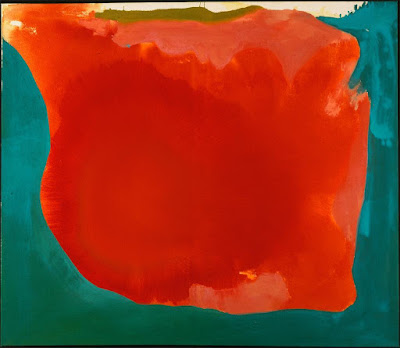-painters making paintings after that/new painters inspired/draw from newman
-blurred, loose painting, mixing paint on the palette
-painters painting like/trying to make paintings look like abstract
 |
| vir heroicus sublimus- barnett newman 1950-51 color field painting large abstract planes of color small vertical lines called zips |
 |
| four darks in red-mark rothko |
 |
| rothko chapel |
 |
| canyon- helen frankenthaler 1965 title responding to the image it created (painting came first then the title) |
- Greenberg uses Helen Frankenthaler as a bridge between Rothko & Pollack (painters in 1960s)- color from Rothko, horizontal work from Pollack
 |
| whirl- kenneth noland 1960 concentric circles, geometric no color mixing |
 |
| shoot- noland 1964 triangular, no color mixing, geometric, symmetrical big scale 103 x 126, extremely flat compare to mondrian's linearity or cezanne's bathers in triangularity |
 |
| cleopatra flesh- jules olitski 1962 height of modernist painting (greenberg) |
 |
| delta theta- morris louis 1961 |
 |
| flag- jasper johns 1954, 3' 6" x 5'1" symbol: american flag- we all know it flat, geometric applique newspaper & encaustic wax to build up/layer surface on panel |
 |
| target w four faces- jasper johns 1955 following "rules" by making it geometric but has texture & is referential compare w noland's whirl weird elements at top- bottom of faces |
- greenberg emphasizes object
- jasper johns emphasizes maker
 |
| marilyn diptych- andy warhol 1962 what makes a warhol a warhol is him & his personality |
- rauschenberg met joseph albers, john cage at black mountain
-farm, cabins, classes (very strict about what kind of artwork they wanted you to make; rauschenberg was trying to make paintings that nobody has made before but albers hated it so he hid them from albers)
 |
| skyway-rauschenberg |
___________________________________________
REALISM
- naturalism: representing objects as they exist in the real world & how things act upon them
- realism: more political, representing real life & struggles
 |
| lady agnew of lochnaw- john singer sargent 1893 naturalism 100cm x 124cm bedroom flirty eyes |
 |
| forty-two kids- george bellows 1907, 42x60 in. uses photography as a way to create compositions & from those photographs, he abstracts everything |
 |
| two girls- isabel bishop |
-professor argues as realism
-when writing about art, literally describe what you see
-when writing about art, literally describe what you see
 |
| woman w a red umbrella seated in profile- henri matisse 1919-1921, oil on canvas flat, color, investing just as much energy |
 |
| o'hara nude w boots- larry rivers 1954, 8 ft. tall |
 |
| aline by the screen door- fairfield porter 1971 green vs. pink artist is individual observer principles of abstraction & modernist painting & applying to every day life |
easter (1958), snow (1958), columbus day (1967)- fairfield porter
-same view, same tree, same houses
-extended relationship w something, coming back to it
-conservative notion of observer & artist, still rooted in reality
-he's mediating the images
- warhol- disjointed observer, observes through mediated images
 |
| early new york evening- freilicher 1954 quality of painting changes elements of matisse turn focus towards domestic, represented & exist in domestic space |
 |
| peonies on a table- freilicher 1954 ignoring a lot of external factors, separate from their time |
professor: what's the point/pursuit? why would i expect anyone else to care? what does it have to do as a record of my time? what thought goes into this? SO WHAT? does it need to respond to the time you're living in? does it exist outside of the time- what's it do?
porter: we can enjoy the paintings as viewers but seems divorced from reality that we understand & find ourselves in. seems like he's intentionally putting blinders on to everything around him; looking at a rich guy's paintings


















No comments:
Post a Comment